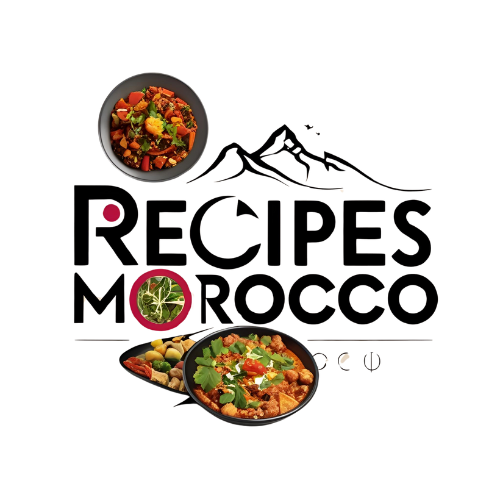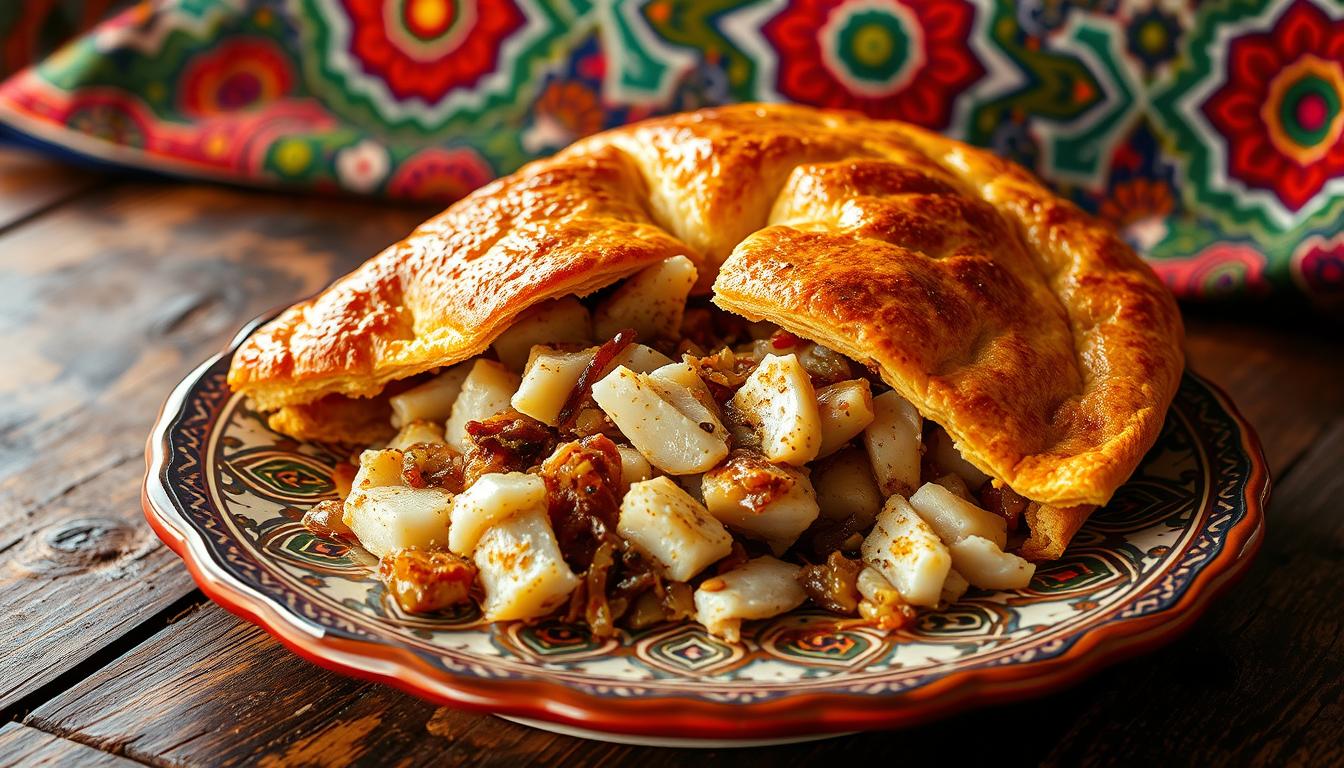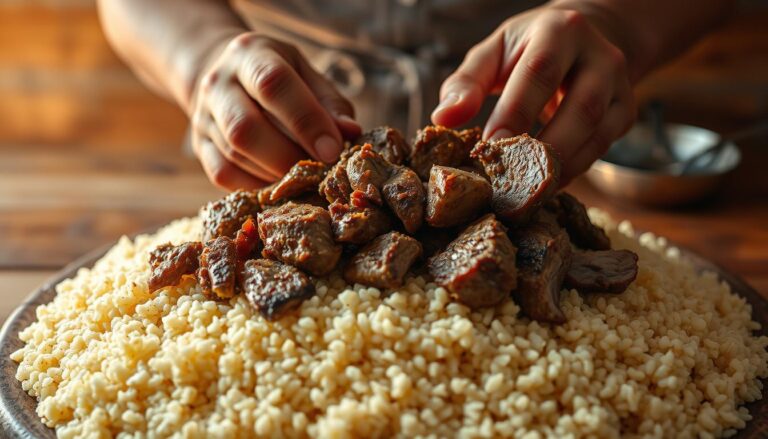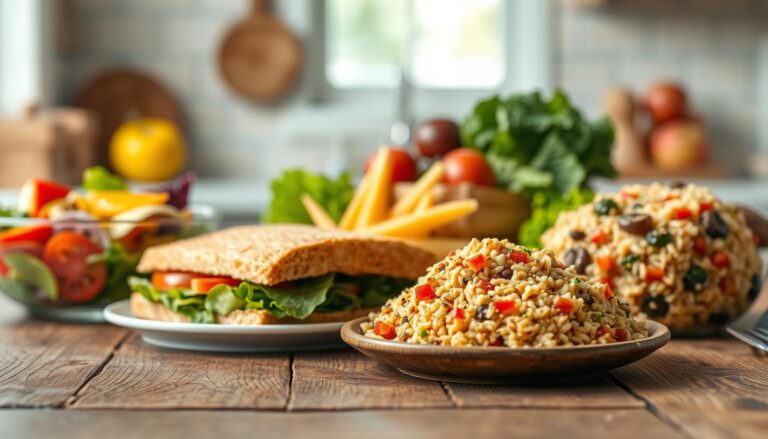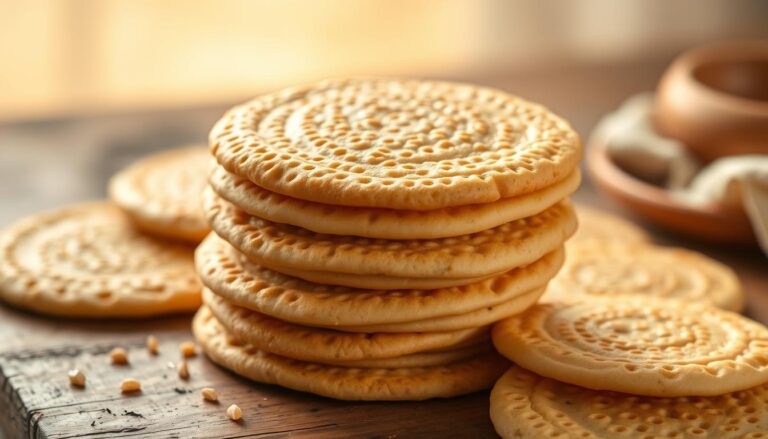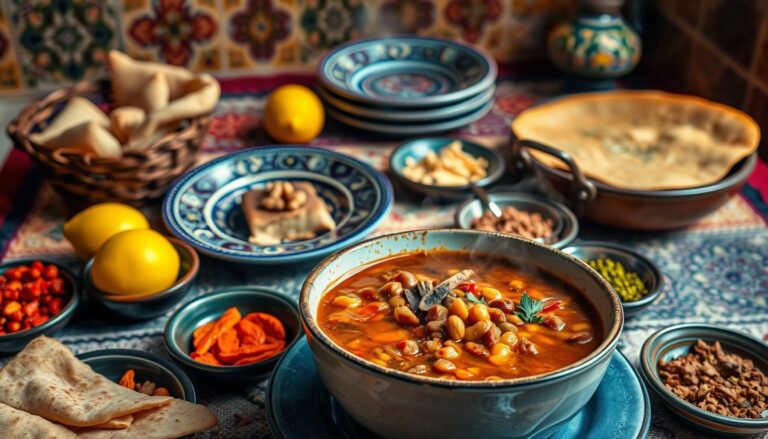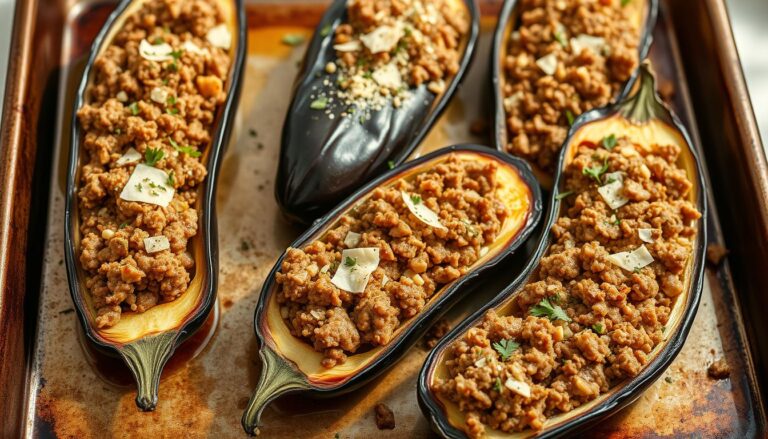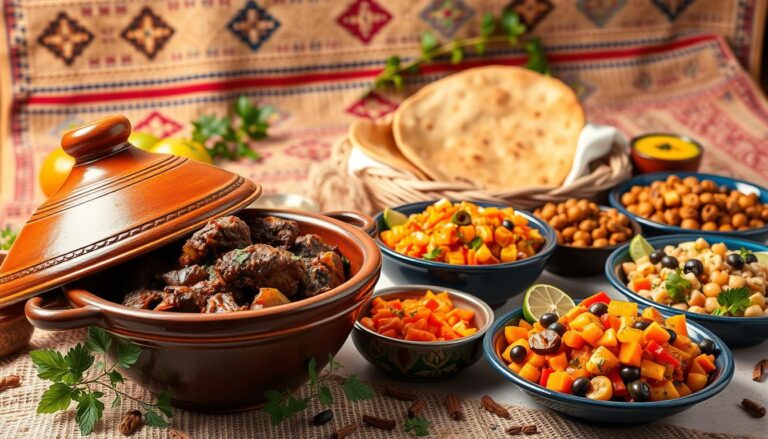Seafood Pastilla: A Flavorful Moroccan Delight
Moroccan cuisine is known for its rich flavors and diverse influences, and one of its most treasured dishes is the Seafood Pastilla. This traditional delight combines the freshness of seafood with the delicate layers of pastilla pastry, creating a culinary experience that is both exotic and familiar.

The unique blend of spices and herbs in Seafood Pastilla reflects the cultural heritage of Morocco, where Mediterranean and African flavors come together. This dish is not only a testament to the country’s culinary creativity but also a reflection of its rich history and cultural diversity.
Key Takeaways
- Seafood Pastilla is a traditional Moroccan dish that combines seafood with pastilla pastry.
- It reflects the cultural heritage and diversity of Moroccan cuisine.
- The dish is known for its unique blend of spices and herbs.
- Seafood Pastilla is a culinary experience that blends exotic and familiar flavors.
- Moroccan cuisine is influenced by Mediterranean and African flavors.
The Culinary Heritage of Moroccan Pastilla
The culinary heritage of Moroccan Pastilla is a fascinating tale of cultural exchange and culinary innovation. This traditional Moroccan dish has a rich history that spans centuries, reflecting the country’s strategic position at the crossroads of Mediterranean and African cultures.
Origins and Historical Significance
Moroccan Pastilla, also known as Bastilla, has its roots in the medieval period, influenced by the culinary traditions of the Andalusian Moors. The original recipe used pigeon meat, wrapped in layers of flaky pastry called ‘warqa.’ This dish was a symbol of hospitality and was often served at special occasions. The historical significance of Pastilla lies in its ability to bring people together, showcasing the rich cultural heritage of Morocco.
The use of local ingredients and spices in Pastilla reflects the country’s history as a trading hub, with influences from Arab, Mediterranean, and African cuisines.
Evolution from Pigeon to Seafood Variations
Over time, the traditional pigeon Pastilla evolved to incorporate various fillings, including seafood, reflecting the culinary creativity and adaptability of Moroccan cuisine. Seafood Pastilla, in particular, has gained popularity, featuring a mix of fresh seafood, aromatic spices, and herbs. This evolution demonstrates the dynamic nature of Moroccan cuisine, as it continues to innovate while maintaining its traditional roots.
What Makes Seafood Pastilla Special
The allure of seafood pastilla lies in its complex flavor profile, which perfectly balances the sweetness of seafood with the savory depth of traditional Moroccan spices. This dish is a true representation of Moroccan culinary art, blending the freshness of the sea with the richness of local ingredients.
The Perfect Balance of Sweet and Savory
A key element that makes seafood pastilla stand out is its delicate balance of sweet and savory flavors. The sweetness comes from the seafood, typically a mix of fish and shellfish, while the savory aspect is contributed by a blend of spices and herbs. This balance creates a rich and complex flavor profile that is both intriguing and satisfying.
Signature Moroccan Spices and Aromatics
The use of signature Moroccan spices and aromatics is another factor that makes seafood pastilla special. Ingredients like cumin, coriander, cinnamon, and ginger add depth and warmth to the dish. The combination of these spices with the seafood filling creates a truly unique culinary experience that is quintessentially Moroccan.
By incorporating these traditional spices and maintaining a balance between sweet and savory, seafood pastilla offers a flavorful journey through Moroccan cuisine.
Essential Ingredients for an Authentic Seafood Pastilla
To make a truly authentic seafood pastilla, one must start with the right ingredients. The dish is a symphony of flavors and textures, and each component plays a crucial role in its overall success.
Selecting the Best Seafood Combination
The seafood filling is the heart of the pastilla. A mix of shrimp, fish, and calamari provides a good balance of flavors and textures. When choosing seafood, consider both the freshness and sustainability of the options.
Fresh vs. Frozen Options
While fresh seafood is ideal, frozen options can be just as good if thawed properly. Frozen seafood is often flash-frozen at peak freshness, preserving its flavor and texture.
Sustainable Seafood Choices
Opting for sustainable seafood is not only good for the environment, but it also ensures the long-term availability of these ingredients. Look for certifications like MSC (Marine Stewardship Council) when making your selections.
Working with Warqa or Phyllo Dough
The pastry layer of the pastilla, whether made with warqa or phyllo dough, is crucial for its signature texture. Warqa dough, traditional in Moroccan cuisine, can be substituted with phyllo dough for a similar effect. Thaw phyllo dough properly to prevent it from becoming brittle.
The Essential Spice Blend
A blend of spices including cumin, coriander, ginger, and cinnamon gives the seafood pastilla its characteristic flavor. Adjust the spice levels to your taste, but keep in mind that the balance of these spices is key to an authentic flavor.
By focusing on these essential ingredients and their preparation, you’ll be well on your way to creating an authentic seafood pastilla recipe that delights the palate.
Kitchen Tools and Preparation Equipment
The art of crafting Seafood Pastilla involves using the right kitchen tools, from traditional Moroccan cookware to contemporary alternatives. To achieve an authentic flavor and texture, it’s essential to understand the equipment needed for preparation.
Traditional Moroccan Cookware
Traditional Moroccan cooking often employs specific cookware that has been used for generations. For Seafood Pastilla, a clay tagine or a heavy-bottomed pot is ideal for cooking the seafood filling, as these vessels distribute heat evenly and retain moisture. Additionally, a wooden spoon or a silicone spatula is recommended for gently stirring the filling without damaging the seafood.
- Clay tagine or heavy-bottomed pot for cooking the filling
- Wooden spoon or silicone spatula for stirring
Modern Kitchen Alternatives
For those who prefer modern kitchen tools or don’t have access to traditional Moroccan cookware, there are several alternatives. A stainless steel or non-stick skillet can replace a clay tagine for cooking the seafood mixture. Moreover, a food processor can be used to chop ingredients quickly, and a pastry brush made of silicone or natural bristles is perfect for applying egg wash to the pastilla pastry.
- Stainless steel or non-stick skillet for cooking
- Food processor for chopping ingredients
- Pastry brush for applying egg wash
Complete Seafood Pastilla Recipe
The process of making seafood pastilla involves several key steps, including preparing the seafood filling, assembling the pastilla, and baking it to perfection. This comprehensive guide will walk you through each stage, ensuring that you can create an authentic and delicious seafood pastilla.
Preparing the Flavorful Seafood Filling
The seafood filling is the heart of the pastilla, and its preparation is crucial. It involves selecting the right mix of seafood and cooking it to the perfect tenderness.
Precooking Techniques
Precooking the seafood is essential to remove excess moisture and to develop the flavors. Techniques include sautéing, steaming, or poaching the seafood until it’s just cooked. It’s crucial to not overcook the seafood at this stage, as it will continue to cook when the pastilla is baked.
Seasoning and Flavor Development
Once the seafood is precooked, the next step is to add the Moroccan spices and aromatics. This includes a blend of cumin, coriander, cinnamon, and ginger, along with some chopped onions, garlic, and fresh parsley. The key is to balance the flavors so that the seafood is enhanced without being overpowered.
| Ingredient | Quantity | Purpose |
|---|---|---|
| Seafood mix (shrimp, fish, calamari) | 1 pound | Main protein component |
| Onions | 1 medium, finely chopped | Adds flavor and texture |
| Garlic | 2 cloves, minced | Enhances flavor |
| Moroccan spice blend | 1 tablespoon | Provides characteristic flavor |
Mastering the Pastilla Assembly
Assembling the pastilla requires some skill, as it involves layering the warqa or phyllo dough with the seafood filling. Brushing each layer with melted butter is crucial for achieving the flaky, golden crust.
To assemble, start with a layer of dough, followed by a layer of seafood filling, and repeat, finishing with a layer of dough on top.
Baking to Golden Perfection
Baking the pastilla is the final step, where the layers meld together, and the crust becomes golden. The baking time and temperature are critical to achieving the perfect pastilla.
A typical baking temperature is around 375°F (190°C), and the pastilla is done when it’s golden brown on top and sounds hollow when tapped.
Troubleshooting Your Seafood Pastilla
The art of crafting seafood pastilla involves more than just following a recipe; it demands troubleshooting skills to overcome common pitfalls and ensure a delightful dining experience.
Preventing Soggy Pastry
Soggy pastry can be a disappointment when serving seafood pastilla. To prevent this, it’s crucial to not overfill the pastilla with the seafood mixture, as excess filling can make the pastry layers soggy. Additionally, brushing the warqa or phyllo dough with melted butter helps to create a barrier against moisture. Ensuring the pastry is baked at the right temperature and for the correct amount of time is also vital.

Fixing Common Filling Issues
The seafood filling is the heart of seafood pastilla, and issues here can significantly impact the dish. If the filling is too dry, adding a bit more moisture from ingredients like lemon juice or white wine can help. Conversely, if the filling is too wet, reducing the amount of liquid or adding more absorbent ingredients like breadcrumbs can balance it out. Ensuring the seafood is not overcooked before mixing it with other ingredients is also crucial to maintaining the right consistency.
Regional Variations of Seafood Pastilla
Regional variations of Seafood Pastilla highlight the creativity and adaptability of Moroccan culinary traditions. This beloved dish is not only a staple in Moroccan cuisine but also a reflection of the country’s diverse cultural and geographical landscapes.
Coastal Moroccan Interpretations
Along Morocco’s extensive coastline, Seafood Pastilla takes on unique flavors and ingredients based on local seafood availability. In coastal towns like Essaouira and Tangier, the pastilla is often filled with fresh catches of the day, such as sardines or anchovies, blended with aromatic spices. The use of locally sourced ingredients not only enhances the flavor but also connects the dish to the region’s rich maritime culture.
Modern Global Adaptations
As global cuisine continues to evolve, Seafood Pastilla has found its way into kitchens around the world, adapting to modern tastes and ingredients. Chefs globally are innovating with this traditional Moroccan dish, incorporating local seafood and spices to create fusion versions. For instance, some restaurants might add a Mediterranean twist by including olives or sun-dried tomatoes in their Seafood Pastilla. These adaptations not only introduce the dish to new audiences but also enrich its culinary heritage.
In conclusion, the regional variations of Seafood Pastilla, from coastal Morocco to global kitchens, demonstrate the dish’s versatility and the dynamic nature of Moroccan cuisine. Whether traditional or modern, Seafood Pastilla remains a delicious representation of Morocco’s rich gastronomic culture.
The Cultural Significance of Pastilla in Moroccan Celebrations
The traditional seafood pastilla is a cherished dish in Moroccan cuisine, playing a significant role in various celebrations. It’s a symbol of hospitality, generosity, and the rich cultural heritage of Morocco.

Festival and Holiday Traditions
In Morocco, seafood pastilla is often served during festivals and holidays, such as Eid al-Fitr and weddings. The dish is prized for its complex flavors and the sense of community it fosters. Families and friends gather around the table to share stories and enjoy the meal together.
The preparation of pastilla is also a communal activity, with family members often participating in making the dough and filling. This collective effort strengthens bonds and creates lasting memories.
Family Gatherings and Special Occasions
Beyond festivals, Moroccan seafood pastilla is a staple at family gatherings and special occasions. It’s a dish that brings people together, evoking a sense of warmth and belonging. The rich flavors and aromas of the pastilla are often associated with happy times and cherished moments.
In many Moroccan households, the preparation and serving of seafood pastilla are considered acts of love and respect for the guests. It’s a way to honor traditions while creating new memories around the dinner table.
Serving and Pairing Your Seafood Pastilla
To make the most of your seafood pastilla, consider its presentation and accompaniments. A well-presented dish not only delights the palate but also pleases the eye, enhancing the overall dining experience.
Traditional Presentation Techniques
Traditionally, pastilla is served dusted with powdered sugar and cinnamon, creating a striking contrast between the sweet and savory flavors. To present your seafood pastilla authentically, follow these steps:
- Dust the top with powdered sugar.
- Sprinkle a pinch of cinnamon.
- Garnish with fresh herbs or edible flowers.
Complementary Beverages and Side Dishes
Pairing your seafood pastilla with the right beverages and side dishes can elevate the meal. Consider the following suggestions:
| Beverage/Side Dish | Description |
|---|---|
| Mint Tea | A traditional Moroccan choice that complements the spices in seafood pastilla. |
| Chilled White Wine | A crisp white wine pairs well with the delicate flavors of seafood. |
| Roasted Vegetables | Roasted vegetables like carrots and zucchini add a healthy and flavorful contrast. |
By thoughtfully presenting and pairing your seafood pastilla, you can create a memorable dining experience that showcases the dish’s unique flavors and cultural heritage.
Conclusion: Bringing Moroccan Flavors to Your Table
Exploring the rich culinary heritage of Morocco through its iconic dish, seafood pastilla, is a journey worth taking. With its delicate balance of sweet and savory flavors, combined with the crunch of warqa or phyllo dough, this traditional recipe is sure to captivate your senses. By following the authentic seafood pastilla recipe outlined in the previous sections, you can recreate the magic of Moroccan cuisine in your own kitchen.
The moroccan seafood pastilla is more than just a dish; it’s a reflection of the country’s cultural diversity and rich history. As you’ve learned, the evolution of pastilla from a traditional pigeon filling to innovative seafood variations showcases the adaptability and creativity of Moroccan cooking. With the seafood pastilla authentic recipe, you’re equipped to impress your family and friends with a truly exotic culinary experience.
Now, it’s your turn to bring a taste of Morocco to your table. Experiment with different seafood combinations and spices to make the seafood pastilla recipe your own. Whether you’re hosting a dinner party or simply looking to spice up your meal routine, this dish is sure to delight. So, gather your ingredients, layer your pastilla with love, and savor the flavors of Morocco.
FAQ
What is seafood pastilla?
Seafood pastilla is a traditional Moroccan dish that combines seafood with the delicate layers of pastilla pastry, creating a unique and flavorful culinary experience.
How do I make seafood pastilla?
To make seafood pastilla, you will need to prepare a flavorful seafood filling, assemble the pastilla using warqa or phyllo dough, and bake it to golden perfection. You can find a detailed recipe in our guide.
What type of seafood is best for seafood pastilla?
The best seafood combination for pastilla typically includes a mix of shrimp, fish, and mussels. You can choose fresh or frozen options, depending on availability and preference.
Can I use frozen seafood for seafood pastilla?
Yes, you can use frozen seafood for pastilla. However, make sure to thaw it properly and pat it dry before using to avoid excess moisture.
What is the difference between warqa and phyllo dough?
Warqa and phyllo dough are both used to make pastilla pastry, but warqa is a traditional Moroccan dough made with flour, water, and salt, while phyllo dough is a more readily available alternative that can be found in most supermarkets.
How do I prevent soggy pastry in my seafood pastilla?
To prevent soggy pastry, make sure to not overfill the pastilla, and bake it at the right temperature. You can also brush the pastry with egg wash or melted butter to help it brown and crisp up.
What are some common issues with seafood pastilla filling?
Common issues with seafood pastilla filling include overcooking the seafood, not balancing the flavors, or using low-quality ingredients. You can troubleshoot these issues by adjusting your recipe and cooking techniques.
Can I make seafood pastilla ahead of time?
Yes, you can prepare the seafood filling and assemble the pastilla ahead of time, but it’s best to bake it just before serving to ensure the pastry stays crispy.
What are some traditional Moroccan beverages to pair with seafood pastilla?
Traditional Moroccan beverages that pair well with seafood pastilla include mint tea, orange juice, and Moroccan wine. You can also consider serving it with a refreshing salad or side dish.
How do I store leftover seafood pastilla?
To store leftover seafood pastilla, let it cool completely, then wrap it tightly in plastic wrap or aluminum foil and refrigerate or freeze. Reheat it in the oven or microwave when you’re ready to serve.
